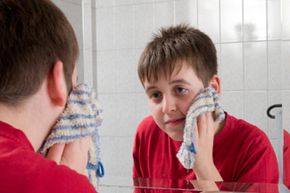Take a quick stroll down the soap and cosmetics aisle in most grocery stores, and you'll begin to get the feeling that you need an advanced degree in either rocket science or brain surgery to get clean. There are hundreds of different soaps, cleansers, astringents, toners and moisturizers on the market. But when it comes down to washing your face, you really just need soap, water and a little effort.
Should you add a washcloth to that mixture? A washcloth can help remove dead skin cells and invigorate the live cells on your face. A gentle scrubbing with a soft washcloth once a day will help keep your skin smooth and clean. But there are several things you should keep in mind when using washcloths.
Advertisement
You should never scrub too vigorously with a washcloth. Removing dead skin cells is a good thing, but if you scrub too hard, your skin may appear red and irritated afterward. A gentle scrubbing is all you need to get rid of dead skin. If dry skin is a persistent problem, avoid using products that contain alcohol -- alcohol will cause your skin to become tight and dry. Apply a moisturizer immediately after washing your face while your skin is still damp.
Always use a clean washcloth every time you wash your face. Hanging a used washcloth up for use later is a bad idea. Bacteria thrive in moist environments such as a wet washcloth. Washing your face with a washcloth that hasn't been cleaned could spread the bacteria on your skin, potentially leading to an illness or infection.
Washing washcloths after every use isn't the most green-friendly practice. You'll consume more water than you would if you washed your face without a washcloth. Most of the time, you can just use some soap and water on your bare hands to wash your face. You can also purchase one-use cleansing pads, though that means you'll be generating more waste as you throw out each used pad.
Washing your face once a day but using a washcloth only occasionally to remove dead skin may be the best routine for both your skin and the environment.
Learn more by following the links on the next page.
Advertisement

